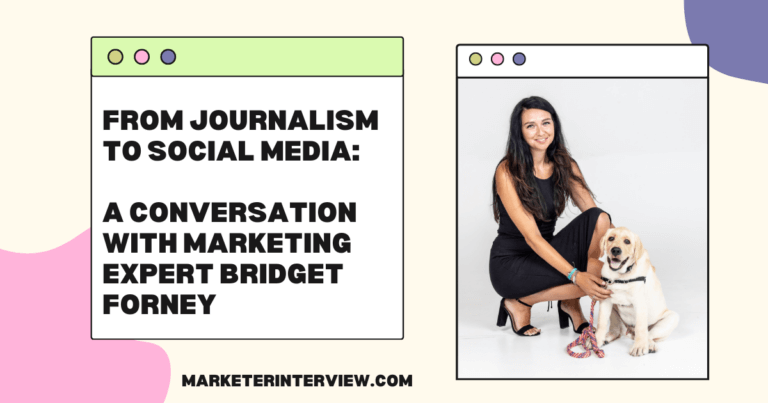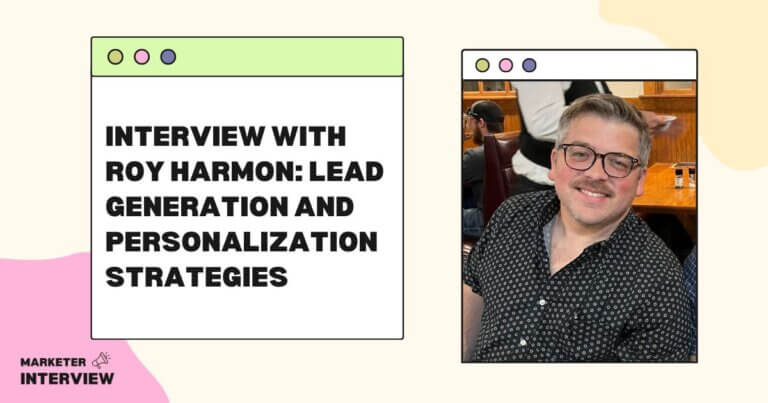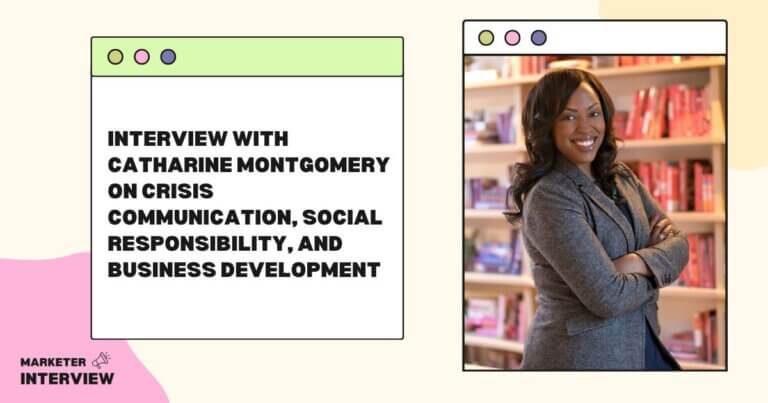Interview with Paige Arnof-Fenn: Insights on Branding & Entrepreneurship
Today we have the pleasure of speaking with Paige Arnof-Fenn, the founder and CEO of Mavens & Moguls, a global marketing consulting firm based in Cambridge, Massachusetts.
With over 30 years of experience in marketing and branding, Paige has worked with various clients ranging from startups to Fortune 500 companies, including Colgate, Virgin, and The New York Times Company.
She has also been featured in numerous publications, including Forbes, Inc., and Entrepreneur.
In this interview, we’ll discuss Paige’s background, her insights on marketing and branding, and her advice for entrepreneurs looking to build successful businesses.
Let’s dive in!
Contents
- 1 Can you tell us about your marketing journey? How did you become a branding expert?
- 2 What are the key elements that companies need to consider when developing their brand strategy?
- 3 How do you create a cohesive brand identity that resonates with your target audience?
- 4 What are some of the biggest mistakes that companies make when it comes to branding?
- 5 How do you approach content marketing for your clients?
- 6 What are the best ways to measure the success of a content marketing campaign?
- 7 Why do brands need to establish themselves as thought leaders in their industry?
- 8 How do you help your clients become thought leaders?
- 9 What are some of the tools and software that you use to create and manage content?
- 10 Can you share some advice for aspiring marketers who want to become experts in branding?
Can you tell us about your marketing journey? How did you become a branding expert?
After graduating college with a degree in Economics, I started my career in finance on Wall Street in the 80s. However, I realized early on that I wanted to switch career tracks.
Being a Financial Analyst in investment banking paid well, but I did not love the work. The hours and lifestyle did not leave time for anything else, so after 2 years, I decided to go back to school for my MBA, which allowed me to rebrand myself, try a new area as a summer intern in marketing, gain new skills and build my network and my confidence.
Getting an MBA was critical for finding work I enjoyed and smoothly transitioning. I took marketing classes and gained experience on and off campus to help me build a resume in the new field, which gave me credibility as a marketer.
I positioned myself as strong analytically, which would help me be a better marketer using data to make decisions. It is possible to rebrand yourself if you are strategic about the process.
It is crucial to have a story to explain your transition and show confidence in your decision, not to be defensive. The skills and activities I liked best in my finance career were the ones that would make me a better marketer.
My 3 favorite parts of my Wall Street job were:
- After the deals were finalized, I got to plan the closing dinners (i.e., event marketing)
- Selecting and purchasing the deal toy to commemorate the successful event/IPO/merger (i.e., promotions)
- Running tombstone ads in NYT and WSJ to commemorate and celebrate the deal (i.e., advertising).
My epiphany was that I was not a finance person at all. Instead, I was an excellent marketer! Once I shared that perspective, the recruiters understood my interest and offered me jobs.
I have loved the work and have been in marketing ever since, first going in-house at large Fortune 500 firms like Procter & Gamble and Coca-Cola, then running marketing at 3 successful startups, and now as an entrepreneur who started a marketing company 21 years ago.
What are the key elements that companies need to consider when developing their brand strategy?
Starting my marketing career working for world-class brands, including Procter & Gamble and Coca-Cola, was excellent training.
A brand is a promise in the hearts & minds of your customer of a consistent experience. You know, when you walk into a Starbucks or McDonald’s and order a Frappuccino or Big Mac, precisely what you are getting whether you are in California, NYC, or London. It will be the same everywhere, and that is comforting and reassuring.
Brands deliver promises. We have come to expect that, and it makes us happy. It is important for a company to own specific real estate in their customers’ brains so they know exactly where to go to find it.
Brands help you stand out from your competition. Without a brand, you are a commodity, so you have to compete on price. A brand is what makes you visible and considered by customers.
How do you create a cohesive brand identity that resonates with your target audience?
Branding is critical to growing your business because if you do not brand yourself, the market will brand you instead.
Start with the fundamentals: Who are you, and why should anyone care? There’s a lot of noise in every category, so if you don’t have a unique story and a new approach or idea that excites you, go no further.
Every great business is built on a great story, so start telling yours to potential customers and see if they buy what you’re selling. But, of course, the most critical ingredient to creating a great brand is authenticity.

Here are a few tips from my experience to help establish an authentic brand identity without spending a lot of money:
Be original: What makes you unique or special?
Think about brands like Chick-Fil-A. They do not try to compete with other fast food brands on menu items. Instead, they are all about chicken, have fantastic customer service, and are closed on Sundays as a corporate policy, yet continue to grow.
Be creative: How do you want people to think & feel after interacting with you vs. your competition?
Brands like Apple and Virgin transcend the products they sell. It is about a lifestyle and way of life when you consider purchasing from them.
Be honest. Let your brand be known for speaking the truth, and you become the trusted advocate and go-to source.
Any woman can relate to the Spanx and Dove brands. For example, they show real women and bodies in their ads with problems their audience can relate to easily.
Be relevant. Brands aren’t created in a vacuum.
Nike does a great job of signing athletes across multiple sports to reach their audiences, from Serena Williams to Tiger Woods to Colin Kaepernick and LeBron James.
So whether you are young or old, male or female, it is winter or summer, Nike has someone you can relate to on their roster.
Be consistent. Develop a cohesive message, and live it every day.
Coca-Cola has been around for over a century, and you do not need to see the logo to know it is a Coke ad. They always have the familiar bottle/can, colors, and images that build on their past and leverage the nostalgia for the brand.
Be passionate. Everyone loves to work with people who are passionate about what they do. It makes life much more fun and exciting.
This is the bonus strategy where brands can stand out. It is hard to fake passion when your employees love their jobs, the customers feel it, too, and brands that create evangelists have a substantial competitive advantage in the market. Apple and Chick-Fil-A understand this, and it shows.
What are some of the biggest mistakes that companies make when it comes to branding?
More than brand awareness is needed. You have to stand for something.
It doesn’t matter if you call it brand purpose or personality, but people need to know more than what you sell. When buyers have a better idea of what your brand stands for, that builds loyalty today.
Being invisible is a terrible strategy, so ensuring a consistent brand presence is essential. Develop a cohesive message, and live it every day.
Make sure you become known as a reliable source with social media profiles and personas that tell the same story. It can be confusing and dilute your brand if you appear serious/buttoned up on one site and a comedian on another.
Don’t spread yourself too thin on social media. It should always look and sound like you and the brand you have built, whether yours is polished or more informal, chatty or academic, humorous or snarky. It is a way for your personality to come through.
Everyone will not like or hire you, but for those who would be an excellent fit for you, make sure they feel and keep a connection and give them a reason to remember you so that when they need your help, they think of your brand first.
How do you approach content marketing for your clients?
Content marketing is the new PR by leveraging social media to build your brand.
When your articles/talks become available online, send them to all your friends/followers/contacts via social media. With content, if you get mentioned/noticed/tagged by key influencers or the media, it can put your brand on the radar/sell out your entire inventory in hours/days.
Content is only growing in importance, and the opportunities to repurpose/refresh/reuse content will continue to escalate in 2023.
Repackaging articles containing outdated information or updating your keywords takes little time. The possibilities are endless and pay off quickly with increased traffic and engagement.
There are a lot of ways to repurpose content, but the ones my clients and I have had the best success with include the following:
- Turning a series of articles, blog postings, or newsletters into a book or e-book
- Turning each chapter of a book/e-book into a series of articles, blog postings, or newsletters
- Turning every piece of content into a tweet
- Share links to the content on all your social media platforms
- Finding like-minded groups with a newsletter or website to do a swap and share content with each other’s audiences
I have also turned articles into infographics and talks that have been videos that I have been able to share over social media and on my site.
Once you have a piece you are happy with, it makes sense to get as much mileage out of it as possible. There are so many media outlets today looking for fresh content, so find creative ways to leverage your thought leadership pieces so your audience finds you as easily as possible.
Research shows that consumers need to be exposed to things many times before they take note, so even though you may think your content is already out there, chances are no one is sick of reading it yet, trust me.
What are the best ways to measure the success of a content marketing campaign?
Content marketing success isn’t just about getting people to your site. It’s also about keeping them there.
If people are spending time on your site or even coming back, you know your content is working, and you’re on the way to generating leads and sales.
If people leave within a few seconds, you’ve got a problem. But if your analytics data shows they are reading to the end and even checking out other content or subscribing to your newsletter, then you know that content is effective.
Measuring how your website visitors interact with your content is an excellent way to ensure you attract the right traffic.
I recommend you look at your bounce rate as the key metric, because engaged visitors will spend more time on your site and view more pages if interested in your offer.
Why do brands need to establish themselves as thought leaders in their industry?
Thought leadership includes hosting webinars/podcasts/speaking at online/offline conferences/writing articles/building your following on social media, which all contribute to increasing your awareness with potential customers/building your credibility.
It takes time to build a reputation that gives you that status. But first, you must develop your knowledge and expertise in a particular niche which is an ongoing process to stay relevant and current.
Instead of trying to start my blog or newsletter, I have had success regularly contributing to existing well-trafficked blogs in my industry or newsletters of like-minded organizations reaching the same target audience as me. I put my URL or contact info on it so they can find me and follow up if they are interested.
Start small and build as you go.
I started speaking at local events and then submitted proposals to speak at industry conferences, and trade shows nationally and eventually globally before the virus hit.
The same advice goes for writing: start with small publications, then move up the food chain to reach bigger audiences.
Don’t let social media drive you crazy. You do not need to be everywhere. It does not matter which platform you choose. Just pick one or 2 that are authentic to you. It should look and sound like you and the brand you have built.

For professional service businesses like mine, LinkedIn matters the most. To present yourself as a quotable source in your industry, post interesting and educational content by sharing a great article you’ve read recently.
If you genuinely want to make valuable connections and represent yourself as a talented thought leader in your industry, you should be crafting your articles on LinkedIn.
How do you help your clients become thought leaders?
The key is to keep the quality high for a steady quantity.
To generate ideas, I suggest looking at the calendar to see if there are any natural opportunities based on the season or activities. Keep a running list of topics you get asked about, and note when you read or hear about something new you want to explore further, a trend, theme or idea that catches your attention.
If an issue affects your business, it will likely be a topic that impacts others too. So, once you decide on an idea to write about, research the subject, talk to people for input, and just start typing.
If you have a unique perspective to share or any advice you think may help others, get it out via social media or whatever distribution vehicle makes the most sense.
What are some of the tools and software that you use to create and manage content?
Keywords are an essential part of SEO strategy today, whether trying to achieve top placement in search listings or purchasing online advertising based on specific keywords/phrases to get more traffic to your site.
The goal is to drive the right traffic at the right time by using keywords in your advertising/web content to increase your visibility/ranking.
When your site is optimized for keywords/phrases, and the content is relevant/high quality/useful, it will result in a higher ranking which is more likely to get you on the first page since most people look no further in their searches.
Social listening tools are also great because we spend so much time on social media that it is becoming more important to listen to online conversations to derive sentiments.
Social media is highly dynamic, so there is more context on the source of ideas, complaints, purchase behavior, and macro/micro trends. Using social listening, you can isolate the data you care about and watch for short-term indicators around consumer research to help identify actionable opportunities early.
With SEO using long-tail search terms/different variations of words is helpful too, so instead of just using “branding,” try including terms like “personal branding,”/“personal branding statement,”/“personal branding examples,”/“personal branding tips” to capture more traffic/interest.
The most critical free tool is Google Analytics to track performance across channels/understand which sources, including specific keywords, bring the most traffic to the website.
Keyword research tools show what your audience is searching for and the questions it’s asking around a topic, giving you something to tap into with content. Also, free Google Trends shows you search trends/the popularity of specific phrases over time.
So much success in marketing is about effective communication online and offline and being a student for life.
The best marketers like asking many questions and are naturally curious.
No single personality type is set up to succeed: Everyone should walk the streets and notice their surroundings. Do they know what movies won at the box office? Books on the NYT bestseller list? Top Billboard and Grammy songs? Why was Game of Thrones popular?
Even if it is not to your taste, you need to know about these things and have an opinion.
A career in marketing and communications is about relevancy, so every day, you have to pay attention to pop culture, trends, etc. So you have to keep your antenna up!
You have to be driven, focused, intensely curious, and always look for ways to make something better, be a good listener to clients, colleagues, feedback, and the market to show respect for great ideas and communicate well.
You will be great in marketing with these traits and a strong work ethic.






